Melodic interval performance
Appendix I
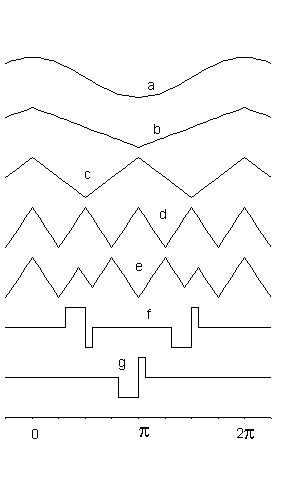 Figure 1. Forms of the voltage functions of some primary tones. From top to bottom: Sinonde(a), F1(b), F2(c), F4(d), Sesquialtera(e), Cromorn(f), Trompe(g). The respective phases shown are the real ones. |
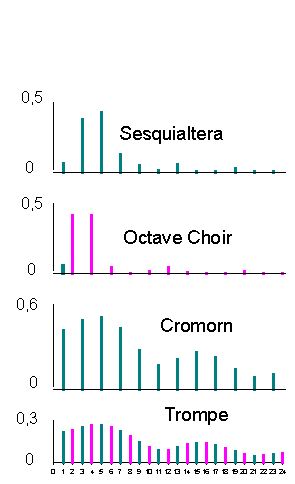 Figure 2. Relative spectra of complex stimuli (first 24 orders only). Colours: Green for odd partials, Pink for even partials. |
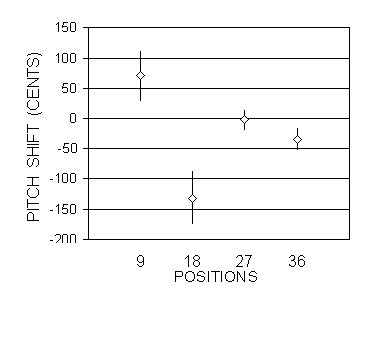 |
Figure 3. Subjective pitch shifts observed in changing timbre from Sesquialtera to Sinonde, by hearing-impaired subject PB-LE (left monaural). Bars indicate two standard deviations. |
 |
Figure 4. Subjective pitch shifts by changing timbre from flute F1 to Octave Choir. Right monaural hearing by aided subject PBa. Bars indicate two standard deviations. |
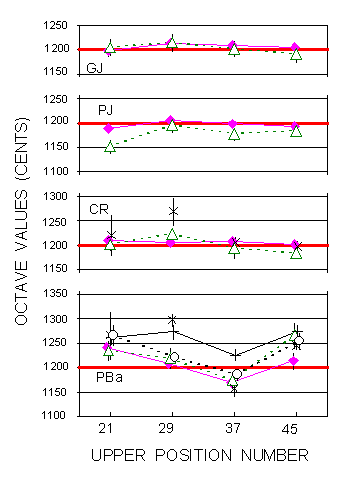 |
Figure 5. Values of descending octaves adjusted by 4 listeners from 4 positions. Right ear monaural listening, PBa using an hearing aid. Symbols for timbres : Sinonde : slanted crosses, no line (only CR, PBa). Octave Choir : filled diamonds, solid line. Sesquialtera : unfilled triangles, dashed line. Trompe : upright crosses, solid line. Cromorn : unfilled circles, dashed line. Some symbols are slightly shifted aside to improve legibility. |
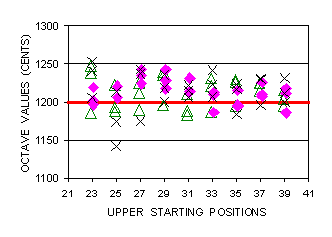 |
Figure 6. Descending octaves by FXS from 9 positions (226.4 to 570.7). Timbre coding : Filled diamonds for Octave Choir. Unfilled triangles for Sesquialtera. Crosses for Sinonde. For more display clarity symbols for Octave Choir and Sesquialtera have been slightly shifted to right and left. |
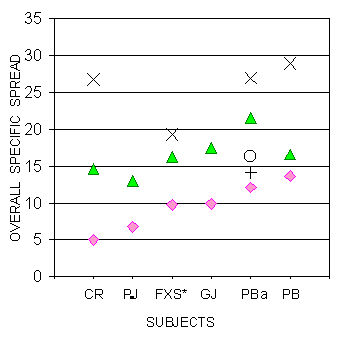 |
Figure 7. Overall specific spreads of octaves of different listeners. Timbre coding : Filled diamonds for Octave Choir. Triangles for Sesquialtera. Slanted crosses for Sinonde. Unfilled circle for Cromorn. Upright cross for Trompe. Subjects CR, PJ, GJ, operated in monaural right ear. FXS operated in monaural left ear. PBa operated in monaural aided right ear, and PB in monaural bare right ear. |
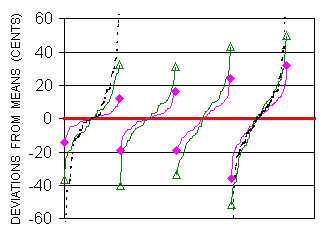 |
Figure 8. Distributions of deviations to means of octaves for 4 listeners and 3 timbres. The listeners are from left to right: CR, PJ, GJ, PBa. Presentation in increasing value order, with constant abscissae increments adjusted for equal widths among listeners and timbres. Symbols: Dashed line: Sinonde. Solid line and ending filled diamonds: Octave Choir. Solid line and ending unfilled triangles: Sesquialtera. A few points of Sinonde falling outside the ordinate limits have the following values : For CR +63.9, -62.6, -86.3. For PBa +93.4, -64, -66.8, -75. |
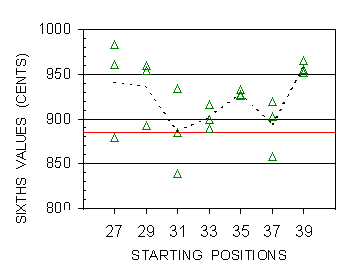 |
Figure 9. Descending sixths by subject FXS in Sesquialtera. Triangles correspond to the 21 individual adjustments from the different positions. Respective frequencies: 285.3, 320.2, 359.5, 403.5, 452.9, 508.4, 570.6 Hz. Horizontal line indicates the perfect value of 884 cents. Dashed line connects the means of positions values. |
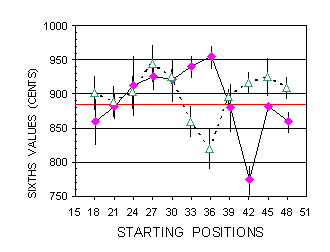 |
Figure 10. Descending sixths of subject PBa from 11 positions ranging from 169.6 to 959.6 Hz by 300 cents steps (respective frequencies: 169.6, 201.7, 239.9, 285.3, 320.2, 339.3, 359.5, 403.5, 452.9, 479.8, 508.4, 570.6, 678.6, 807.0, 959.6 Hz). Symbols : Octave Choir, filled diamonds and solid line. Sesquialtera, unfilled triangles and dashed line. The red horizontal line marks the 884 cents theoretical sixth value (frequency ratio 5/3). Slight aside shifts for more legibility. |
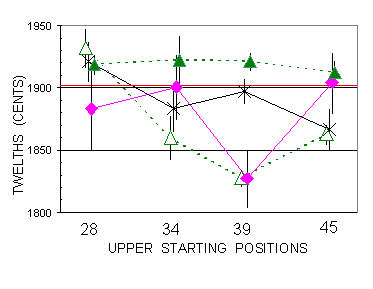 |
Figure 11. Descending twelfths by subjects PBa and CR, from 4 positions. Symbols : filled triangles and dashed line for Subject CR and Sesquialtera. Unfilled triangles and dashed line for PBa and Sesquialtera. Crosses and thin line for PBa and Sinonde. Filled diamonds and solid line for PBa and Octave Choir. The thick horizontal line at 1902 cents corresponds to theoretical twelfth (frequency ratio 3). Slight aside shifts for more legibility. |
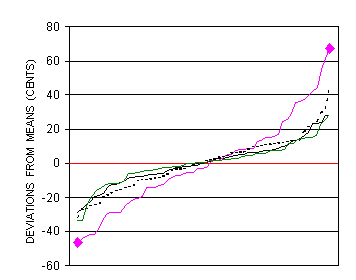 |
Figure 12. Distributions of deviations from means of descending twelfths of subjects CR and PBa. Presentation in increasing order, with adjusted abscissae for equal horizontal widths of curves. Symbols : Thin solid line for CR and Sesquialtera. Thin solid line ended by filled diamonds for PBa and Octave Choir. Thick solid line for PBa and Sesquialtera. Thick dashed line for PBa and Sinonde. |
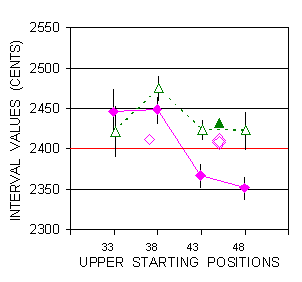 |
Figure 13. Descending fifteenths by subject PBa from positions 33,38,43,48 (frequencies 403.5, 538.6, 718.9, 959.6 Hz). Symbols : filled diamonds and solid line for Octave Choir. Unfilled triangles and dashed line for Sesquialtera. Thick horizontal line at 2400 marks theoretical perfect interval. Isolated unfilled diamonds and filled triangle refer to 4 unintentional fifteenths by subjects PJ and GJ at positions 37 and 45, during octave sessions (see Table II). Slight aside shifts for more legibility. |
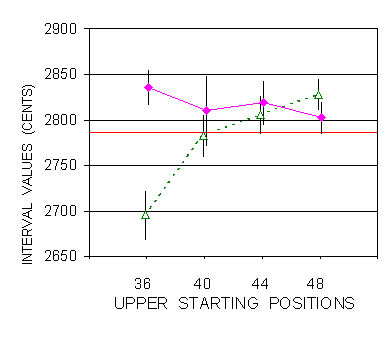 |
Figure 14. Descending seventeenths by subject PBa. Same symbols as in Figure 13 for PB. The thick line at 2786 indicates the perfect seventeenth (frequency ratio of 5). Slight aside shifts for more legibility. |



